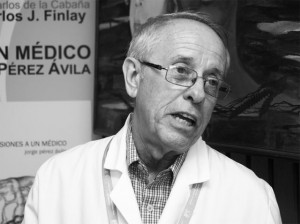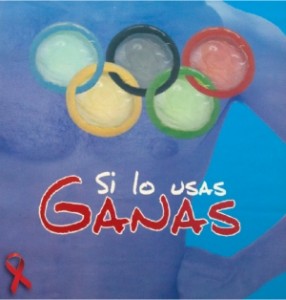Cuba’s Combat of HIV/AIDS
March 1, 2012 by cahunt
Public health is a facet of Cuban culture that the government has not hesitated to fully fund and support. It is especially important to focus on Cuba’s programs for HIV/AIDS treatment and prevention, which have been globally recognized for their success.
Cuba rapidly responded to knowledge of the disease’s existence in 1983 with the establishment of the National Commission on AIDS, prior to Cuba identifying any Cuban citizens with HIV or AIDS (Barksdale 2009). Two years later, large-scale testing of the population began, and condoms were introduced as a method of HIV-AIDS prevention. In addition to taking swift action to combat the disease, Cuba has been able to obtain and produce seven of their own anti-viral medications. This is impressive considering the U.S. embargo which restricts trade of antibiotics and other prescription medications (Barksdale 2009).
A key figure in Cuba’s HIV-AIDS prevention is Jorge Perez, M.D., an infectious disease expert trained at McGill University. Though it was unclear whether the disease behaved like a normal virus and spread through normal viral transmission, Perez had an “educated hunch” that HIV transmission through blood was possible, and thence ordered that all foreign-derived blood products to be eliminated in 1983, two years before Cuba would have any citizens diagnosed as HIV-positive. This preemptive measure enabled Cuba to avoid what could have been a disastrous spread of the virus to blood transfusion recipients.
Cuba’s approach to its HIV-positive citizens has been meticulous and vigilant, yet also holistic and accepting. In the 1990’s, Cuba followed classic public health procedures and instituted a quarantine of HIV-positive patients as well as mandatory testing – processes which included the education of patients and their families about HIV. Though the strict quarantining received criticism for being extreme, it effectively contained the spread of HIV/AIDS. In 1994, Jorge Perez successfully urged the government to terminate the stringent quarantine policy and personally oversaw that the locations of HIV/AIDS sanatoriums were convenient and optimal for patients. Though long-term residence at sanatoriums is voluntary, patients there benefit from readily available and government subsidized “proper nutrition, shelter and medication dispensation.” Although its merits were highly debated, the initial quarantine of HIV-positive patients was crucial to combating the spread of HIV. Subsequent HIV/AIDS care facilities however, were and are still are highly adequate means of supporting and caring for HIV/AIDS patients.
Cuba’s low rate of mother-to-child transmission can be attributed to the government’s provision of universal antiretroviral therapy and the careful testing and monitoring of pregnant women. To ensure HIV-negative children, a sizeable portion of the $150 million annually spent on various HIV programs is a allotted to the mandatory testing of all pregnant women. HIV-positive women are also assisted by health care promoters who work to “study HIV-positive women of childbearing age and inform them when their viral levels are undetectable…and therefore at a good point to get pregnant if they wish to,” (Ravsberg 2012). Such precautions have been undeniably effective in combating the spread of HIV/AIDS; In 2011, 93 HIV-positive women gave birth, and 92 of those children were healthy, effectively bringing the infection rate down to less than 2 percent.
Not only has the Cuban government recognized the importance of meticulous record-keeping, HIV education and treatment facilities, but it has also largely destigmatized HIV-AIDS. Perez has been highly influential in portraying HIV-positive patients as capable individuals who are able to and should be integrated into work, school, and ambulatory settings. HIV/AIDS programs also acknowledge the need for support to patients and their families through “nutrition, education, prevention and caring, partnered with preventive or interventional therapeutics,” (Barksdale).
Through its immediate and effective HIV/AIDS policies, Cuba has kept its rate of infection down and prevented the widespread outbreaks seen in other islands in the Caribbean. Cuba has “the lowest percentage of its population, a total of 11,243,00 people, infected with the Human Immunodeficiency Virus (HIV) in the Western Hemisphere,” despite the U.S. embargo and other restrictions under which its health care system must operate. In this way, Cuba has effectively addressed the HIV/AIDS epidemic, and has truly demonstrated its egalitarian public health policies in this area.
Sources:
1. Julia Sweig, Cuba: What Everyone Needs to Know (New York: Oxford University Press, 2009)
2. Barksdale, Byron L. <http://www.prairiefirenewspaper.com/2009/02/success-story-of-hiv-and-aids-control-in-cuba>. February 21 2012.
3. Ravsberg, Fernando. “Cuba: Fighting Against and With HIV-AIDS.” Havana Times. HavanaTimes.org, 23 Feb. 2012. Web. 1 Mar. 2012. <http://www.havanatimes.org/?p=62728>.
One Response to “Cuba’s Combat of HIV/AIDS”
Leave a Reply
You must be logged in to post a comment.


Coach training accomplished
» Cuba’s Combat of HIV/AIDS CUBAN TRANSITIONS